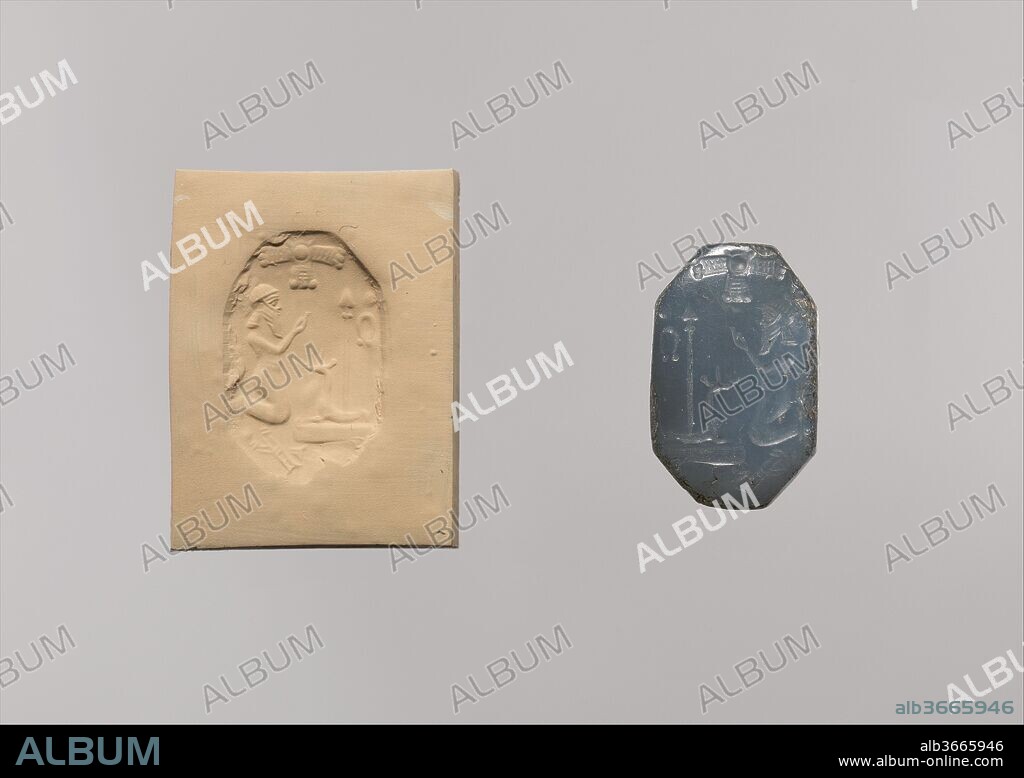alb3665946
Stamp seal: worshiper kneeling before mushhushshu-dragon and standard

|
Añadir a otro lightbox |
|
Añadir a otro lightbox |



¿Ya tienes cuenta? Iniciar sesión
¿No tienes cuenta? Regístrate
Compra esta imagen.
Selecciona el uso:

Título:
Stamp seal: worshiper kneeling before mushhushshu-dragon and standard
Descripción:
Traducción automática: Sello de sello: adorador arrodillado ante mushhushshu-dragón y estandarte. Dimensiones: Cara del sello: 2,41 x 1,55 cm Alto: 3,12 cm Agujero para cuerda: 0,2 cm. Fecha: ca. Siglo VI-V a.C. Este sello representa una figura arrodillada ante símbolos divinos. La figura, barbuda y con diadema, levanta las manos en gesto de oración y súplica. Ante él se puede ver un mushhushshu recostado, el dragón compuesto asociado particularmente con la deidad principal de Babilonia, Marduk, cuya pala "estándar" se eleva desde su espalda. Es posible que el mushhushshu y el estandarte de palas representen un altar real ante el cual la figura se arrodilla, pero otros elementos de la composición son símbolos divinos abstractos: detrás del estandarte se encuentra un símbolo que se asemeja a la letra griega "omega", y encima de la escena hay un disco alado. Muchos diseños de sellos neobabilónicos muestran a un adorador de pie o arrodillado con las manos levantadas ante símbolos divinos o un altar. En algunos casos la figura es imberbe y claramente un sacerdote; en otros, como aquí, la figura puede representar a un sacerdote o un rey. Aunque a menudo están finamente tallados, los sellos se destacan por la simplicidad de sus composiciones y, inusualmente en los sellos del antiguo Cercano Oriente, por la inclusión de grandes áreas de espacio en blanco y sin tallar.
Stamp seal: worshiper kneeling before mushhushshu-dragon and standard. Dimensions: Seal Face: 2.41 x 1.55 cm
Height: 3.12 cm
String Hole: 0.2 cm. Date: ca. 6th-5th century B.C..
This stamp seal depicts a kneeling figure before divine symbols. The figure, bearded and wearing a diadem, raises his hands in a gesture of prayer and supplication. Before him can be seen a couchant mushhushshu, the composite dragon associated particularly with Babylon's chief deity Marduk, whose spade "standard" rises from its back. It is possible that the mushhushshu and spade standard represent a real altar before which the figure kneels, but other elements of the composition are abstract divine symbols: behind the standard sits a symbol resembling the Greek letter "omega," and above the scene is a winged disc.
Many Neo-Babylonian seal designs show a standing or kneeling worshipper with raised hands before divine symbols or an altar. In some cases the figure is beardless and clearly a priest; in others, as here, the figure may represent a priest or king. Although often very finely carved, the seals are notable for the simplicity of their compositions and, unusually for ancient Near Eastern seals, their inclusion of large areas of blank, uncarved space.
Técnica/material:
Chalcedony, blue
Periodo:
NEOBABILONICO
Museo:
Metropolitan Museum of Art, New York, USA
Crédito:
Album / Metropolitan Museum of Art, NY
Autorizaciones:
Tamaño imagen:
4247 x 3006 px | 36.5 MB
Tamaño impresión:
36.0 x 25.5 cm | 14.2 x 10.0 in (300 dpi)
Palabras clave:
 Pinterest
Pinterest Twitter
Twitter Facebook
Facebook Copiar enlace
Copiar enlace Email
Email
